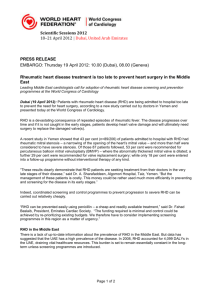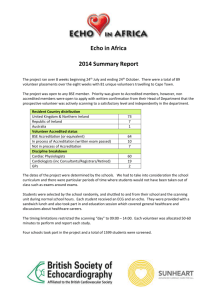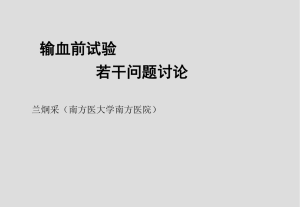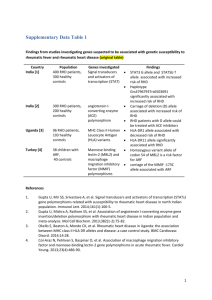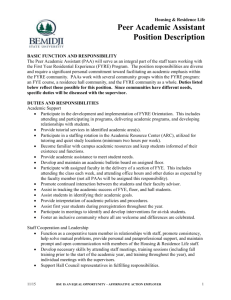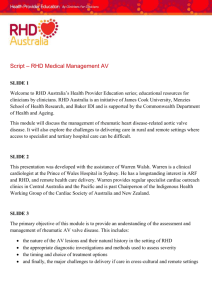Neurophysiological effect of Rh factor
advertisement
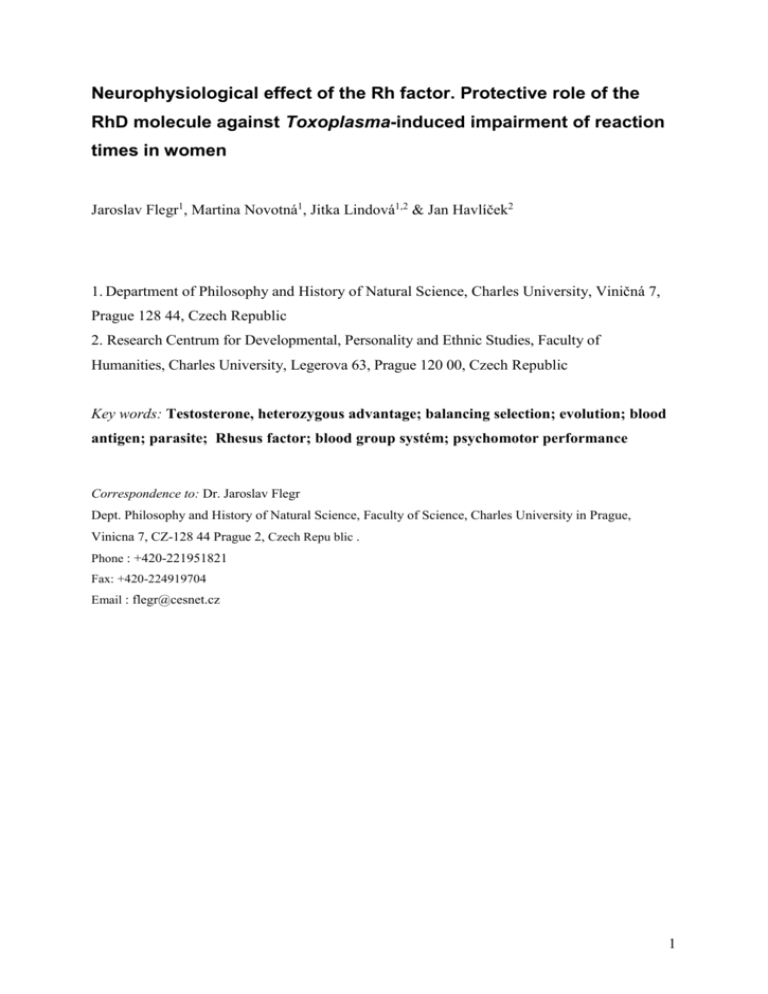
Neurophysiological effect of the Rh factor. Protective role of the RhD molecule against Toxoplasma-induced impairment of reaction times in women Jaroslav Flegr1, Martina Novotná1, Jitka Lindová1,2 & Jan Havlíček2 1. Department of Philosophy and History of Natural Science, Charles University, Viničná 7, Prague 128 44, Czech Republic 2. Research Centrum for Developmental, Personality and Ethnic Studies, Faculty of Humanities, Charles University, Legerova 63, Prague 120 00, Czech Republic Key words: Testosterone, heterozygous advantage; balancing selection; evolution; blood antigen; parasite; Rhesus factor; blood group systém; psychomotor performance Correspondence to: Dr. Jaroslav Flegr Dept. Philosophy and History of Natural Science, Faculty of Science, Charles University in Prague, Vinicna 7, CZ-128 44 Prague 2, Czech Repu blic . Phone : +420-221951821 Fax: +420-224919704 Email : flegr@cesnet.cz 1 Abstract The biological function of RhD protein, a major component of the Rh blood group system, is largely unknown. No phenotypic effect of RhD protein, except its role in hemolytic disease of newborns and protective role against Toxoplasma-induced impairment of reaction times in men, has been described. Here we searched for a protective effect of RhD positivity against Toxoplasma-induced prolongation of reaction times in a set of female students of the Faculty of Science. RhD-positive subjects have been confirmed to be less sensitive to the influence of latent toxoplasmosis on reaction times than Rh-negative subjects. While a protective role of RhD positivity has been demonstrated previously in four populations of men, the present study has shown a similar effect in 226 female students. Our results have also shown that the concentration of testosterone in saliva strongly influences (reduces) reaction times (especially in men) and therefore, this factor should be controlled in future reaction times studies. INTRODUCTION The RhD protein, a product of the RHD gene, is a major component of the Rh blood group system and carries the strongest blood group immunogen, the D-antigen. The structure homology data suggest that the RhD protein acts as an ion pump of uncertain specificity and unknown physiological role [1,2]. This antigen is absent in a significant minority of the human population (RhD negatives) due to RHD deletion. The origin and persistence of this RhD polymorphism, differences in the frequency of RhD alleles between geographically distinct populations, especially the high frequency of RhD negatives in Caucasian populations, are long-standing evolutionary enigmas [3,4,5,6]. Before the advent of modern medicine, the carriers of the rarer allele (e.g. RhD-negative women in a population of RhD positives or RhD-positive men in a population of RhD negatives) were at a disadvantage as some of their children (RhD-positive children born to preimmunised RhD-negative mothers) were at a higher risk of fetal or newborn death or health impairment from hemolytic disease. Therefore, the RhD polymorphism should be unstable, unless the disadvantage for carriers of the locally less abundant allele is counterbalanced by, for example, higher viability of the heterozygotes [7]. Such heterozygote advantage is known to be responsible for polymorphism in hemoglobin genes (and for sickle cell disease) in areas with endemic malaria [8]. The possible role of the parasites in the origin and persistence of the RhD polymorphism is suggested by the pronounced differences in the frequency of particular RhD phenotypes in 2 different geographic areas. The rates of RhD-negative subjects are about 15 % in Caucasians, 8 % in Africans and 1 % in Asians, which corresponds with the allele frequencies of 40 %, 28 % and 10 %, respectively. Recently, lower sensitivity of RhD-positive subjects, in particular RhD-positive heterozygotes, to Toxoplasma-induced prolongation of reaction times has been observed in three independent sets of male blood donors and one set of male conscripts [9]. Toxoplasma gondii, a protozoan parasite that infects 10-60 % of people worldwide, depending on climate, hygienic standards, eating habits and presence/absence of definitive hosts (cats) [10], is known to induce increase of reaction times in infected mice [11] and specific personality and behavioural changes in subjects with lifelong latent infection [12-16]. Infected men and women also have longer reaction times and higher probability of traffic accidents [17,18]. Detailed analysis of the reaction times in a three-minute test suggests that Toxoplasmainfected subjects lose their concentration on the task more quickly than Toxoplasma-free subjects [19]. It has been reported recently that RhD-negative compared to RhD-positive men without anamnestic titres of anti-Toxoplasma antibodies have shorter reaction times in a three minute-test of simple reaction times. And conversely, RhD-negative men with anamnestic titres (i.e. with latent toxoplasmosis) exhibited much longer reaction times than their RhDpositive counterparts. The protective effect of RhD positivity on female subjects has not yet been confirmed. It was speculated that the small number of women among the sampled blood donors (and their absence among conscripts), together with possible confounding effects of hormonal cycles, were responsible for negative results in women [9]. In particular, the concentration of testosterone could bias the results as it is known to correlate with competitiveness [20] and significant decrease in testosterone concentration has been observed in Toxoplasma-infected women compared to Toxoplasma-infected men whose testosterone level was non-significantly increased [21-23]. In the present study, we searched for a protective effect of RhD positivity against Toxoplasma-induced prolongation of reaction times in a set of university students. In contrast to the previous studies, the number of female students in our set was about twice the number of male students, and about two-thirds of subjects were tested for the concentration of testosterone in saliva. MATERIALS AND METHODS 3 Subjects Undergraduate students of biology of the Faculty of Science, Charles University, Prague, were addressed during regular biology lectures and were invited to participate in the study on a voluntary basis. One hundred and ten (110) male students (mean age: 21.0, s.d.: 1.98) and two hundred and twenty-six (226) female students (mean age: 20.9, s.d.: 1.84) were enrolled in the study and signed an informed consent form. All participants provided 2 ml of blood for serological testing and three saliva samples of about 200 μl (collected approximately at 9:00, 11:30 and 13:00). Meanwhile, all participants performed the same panel of psychological and behavioral tests, including a simple reaction time test [15]. All blood and saliva samples were stored in a freezer at -20 ºC until assayed. The recruitment of the study subjects and data handling practices complied with the Czech legislation in force. Psychomotor test Reaction time was measured by the computer version of a simple reaction time test [24]. A yellow square (1 x 1 cm) appeared in a yellow frame (3 x 3 cm) at the centre of a black computer display at irregular intervals ranging from 1 to 8 sec; the length of the test was four minutes. The subject had to respond to the square immediately after it appeared on the display by pressing the Enter key of the notebook keyboard. The computer measured and recorded reaction times in each trial and calculated the mean reaction times from all those recorded during each of four minutes of the test. The students were tested in groups of eight (at eight identical computers) and instructions about how to perform the test were written on the first (introductory) computer screen. At the time of testing the subjects were not aware of the results of the immunological assessment of toxoplasmosis. Immunological tests for toxoplasmosis All serological tests were carried out in the National Reference Laboratory for Toxoplasmosis, National Institute of Public Health, Prague. Specific anti-Toxoplasma IgG in all subjects and IgM in high IgG subjects were determined by ELISA (IgG: SEVAC, Prague, IgM: TestLine, Brno; optimized for early detection of acute toxoplasmosis) [25] and the complement fixation test (CFT) (SEVAC, Prague), which is more reliable in established (“old“) T. gondii infections as decrease in CFT titres is more regular [26,27]. Toxoplasma antibody titres in the sera were measured at dilutions between 1 : 8 and 1 : 1024. The subjects testing IgM negative by ELISA (positivity index<0.9) and having CFT titres higher than 1 : 8 were considered latent toxoplasmosis positive. 4 Radioimmunoassay (RIA) for testosterone All testosterone assays were carried out at the Institute of Endocrinology, Prague. The concentration of testosterone in saliva samples was determined by a radioimmunoassay method as described elsewhere [23]. The samples were assayed in triplicates. Because of the low volume of saliva in some samples (the lower limit for reliable assay was 100 μl), the complete testosterone concentration data (all three samples) were not obtained for all subjects. Statistical analysis The SPSS 16.0 and Statistica 6.0 software packages were used independently and in parallel for all statistical testing including General Linear Model tests (GLM), log-linear analysis and testing of statistical test assumptions (normality of data and normality of residuals with Shapiro-Wilks tests and residual graphs, homogeneity of variances with Levene's test for homogeneity of variances and sphericity with Mauchly’s test of sphericity). When the data failed in the test of sphericity, degrees of freedom were adjusted by the Greenhouse-Geisser method. The relation between reaction time (dependent factor) and testosterone concentration was estimated by linear regression. The effects of RhD and toxoplasmosis on reaction time were studied by the GLM and GLM repeated measures tests with dependent variables reaction times in minutes 1, 2, 3 and 4 of the test (continuous variables), independent factors RhD (binary variable RhD), toxoplasmosis (binary variable toxo), and within-subject factor of minute of the test (four level categorical variable time). The significance and strength of effects are shown as two-tailed p and 2, respectively. In some tests, the concentration of salivary testosterone (continuous variable testosterone) was also included in the models. All statistical tests were performed with raw, non-transformed data; however, there was practically no qualitative difference between results of statistical tests performed on a subset of subjects with mean reaction times in a particular minute of the test equal or lower than 350 ms [9] either with or without log transformation of the testosterone concentration data. RESULTS Our experimental set consisted of 110 male and 226 female students. Among 84 (76.4 %) Toxoplasma-free men, 67 (79.8 %) were RhD positive and among 26 (23.6 %) Toxoplasmainfected men, 19 (73.1 %) were RhD positive. Among 194 (85.8 %) Toxoplasma-free women, 158 (81.4 %) were RhD positive and among 32 (18.6 %) Toxoplasma-infected women, 26 5 (81.3 %) were RhD positive. The loglinear analysis of the model containing factors sex, toxo and RhD showed that male students had higher probability of Toxoplasma infection (Chi square = 4.6, p=0.032), while all other interactions between the factors were non-significant. As latent toxoplasmosis is known to influence most personality factors in opposite ways in men and women (a significant effect of sex-toxo-RhD interaction on reaction times in minutes 1 and 4 of the test was observed, data not shown), we analyzed the reaction times separately for men and women. The general linear model analysis of the male students’ data with factors toxo and RhD showed no significant effect of toxo, RhD or toxo-RhD interaction, either in simple analyses of individual test minutes or in the repeated measures analysis with dependent variables reaction time in minutes 1, 2, 3 and 4 of the test (continuous variables), independent factors RhD (binary variable RhD), toxoplasmosis (binary variable toxo), and within-subject factor minute of the test (four level categorical variable time). The power analysis using p=0.05 showed that the observed power of time-toxo-RhD interaction in the repeated measures analysis was only 0.241. The general linear model analysis of the female-students’ data with factors toxo, RhD and continuous variable age showed no significant effect of toxo, RhD or toxo-RhD interaction in simple analyses of the individual minutes. However, the repeated measures analysis with dependent variables reaction time in minutes 1, 2, 3 and 4 of the test (continuous variables), independent factors RhD (binary variable RhD), toxoplasmosis (binary variable toxo), and within-subject factor minute of the test (four level categorical variable time) showed statistically different effects of toxoplasmosis on reaction times in particular minutes of the test (time-toxo interaction: F2.67, 666, p=0.021, 2 = 0.015) and also statistically different effect of toxoplasmosis in RhD-positive and RhD-negative women on psychomotor performance in particular minutes of the test (time-toxo-RhD interaction: F2.67, 666=5.56, p<0.001, 2 = 0.024). Fig. 1 shows that latent toxoplasmosis had a stronger effect on reaction times of RhD-negative compared to RhD-positive women. The RhD-negative Toxoplasmainfected women had longer reaction times in minute 1 of the test and shorter reaction times in minute 4 of the test than RhD-negative Toxoplasma-free women. Latent toxoplasmosis is known to be associated with higher testosterone levels in men and lower testosterone levels in women [23]. The level of testosterone is known to positively correlate with personality trait competitiveness [20]. Thus the results of our reaction times test could reflect not only psychomotor performance of the tested subjects but also their motivation as a result of their competitiveness (and indirectly of their testosterone level). The data on the concentration of testosterone in saliva (average concentration in three samples 6 collected approximately at 9:00, 11:30 (before the test) and 13:00 (after the test) were available for 66 Toxoplasma-free and 21 Toxoplasma-infected men and 138 Toxoplasma-free and 26 Toxoplasma-infected women). The concentration of testosterone negatively correlated with reaction times in all four minutes of the test in men (minute 1: F1,85=7.24, p=0.009, R2ADJ=0.068, minute 2: F1,85=10.10, p=0.002, R2ADJ=0.096 minute 3: F1,85=5.60, p=0.020, R2ADJ=0.051, minute 4: F1,85=5.25, p=0.024, R2ADJ=0.068) but in no minute of the test in women (minute 1: F1,164=0.218, p=0.641, R2ADJ<0.001, minute 2: F1,164=0.40, p=0.530, R2ADJ<0.001, minute 3: F1,164=0.08, p=0.773, R2ADJ<0.001, minute 4: F1,164=1.60, p=0.208, R2ADJ<0.001). To control for the effect of testosterone concentration, we repeated all analyses with testosterone concentration as a covariate. Again, the general linear model analysis for the male students’ data with factors toxo, RhD and continuous variables age and testosterone concentration showed no significant effect of toxo, RhD or toxo-RhD interaction, either in simple analyses for individual minutes, or in the repeated measures GLM analysis with dependent variables reaction time in minutes 1, 2, 3 and 4 of the test, independent factors RhD, toxo, and within-subject factor time (minute of the test). The effect of testosterone concentration was significant in all minutes of the test (minute 1: F1,82=6.90, p=0.010, minute 2: F1,82=12.09, p<0.001, minute 3: F1,82=5.40, p=0.023, minute 4: F1,82=6.85, p=0.011). The power analysis using p=0.05 showed that the observed power of time-toxo-RhD interaction in the repeated measures analysis was 0.224. For the female students, the general linear model analysis with factors toxo, RhD and continuous variable testosterone concentration revealed a significant effect of toxo-RhD interaction in minute 1 of the test (F1,159=4.29, p=0.040). The repeated measures analysis with dependent variables reaction time in minutes 1, 2, 3 and 4 of the test, independent factors RhD, toxo, and within-subject factor time (minute of the test) showed different effects of toxoplasmosis on reaction times in particular minutes of the test (time-toxo interaction: F2.57,477=3.28, p=0.027, 2 = 0.020), different (nonsignificant) effect of RhD on psychomotor performance in particular minutes of the test (time-RhD interaction: F2.57,477=2.66, p=0.057, 2 = 0.016) and also different effect of toxoplasmosis in RhD-positive and RhD-negative women on reaction times in particular minutes of the test (time-toxo-RhD interaction: F2.57,477=5.83, p<0.001, 2 = 0.036). The effect of testosterone concentration was not significant in any minute of the test (minute 1: F1,159=0.53, p=0.469, minute 2: F1,159=0.55, p=0.461, minute 3: F1,159=0.11, p=0.743, minute 4: F1,159=1.74, p=0.189). 7 DISCUSSION Our results confirmed that RhD-positive subjects were less sensitive to the influence of latent toxoplasmosis on reaction times than RhD-negative subjects. While our previous study [9] has demonstrated a protective role of RhD positivity in four populations of men (three populations of blood donors N=69, 89, 221 and one population of military personnel N=315), the present study has observed a similar effect in female students. The low number of male students in the present study and of women in the previous study may account for differences in results. In the present study, the power analysis of the male students’ data has shown the probability of such error (Type II error) to be about 75 %. In the previous study, reaction times were tested only by a three-minute test while in the present study, the test was extended to four minutes. In the fourth minute of the test, reaction times of RhD-negative, Toxoplasma-infected women were shorter compared to RhDnegative, Toxoplasma-free women. At the present time, we have no explanation for such a paradoxical effect of toxoplasmosis. Another study is needed to confirm this phenomenon in male subjects using the four-minute test. Reaction times correlated negatively with testosterone level in male subjects. This relation can probably be explained by higher competitiveness and therefore higher motivation of men with higher testosterone levels in saliva [20]. The concentrations of testosterone are known to be higher in Toxoplasma-infected men and lower in Toxoplasma-infected women in comparison with Toxoplasma-free subjects. The performance in our simple reaction time tests in general and in men in particular is likely to have been influenced by both competitiveness, which is enhanced by higher testosterone in Toxoplasma-infected men [20], and psychomotor performance that is negatively affected by Toxoplasma infection [19]. The interplay of these two opposite effects could result in either positive or negative effects of toxoplasmosis and RhD positivity on reaction times in men. In women, both effects of toxoplasmosis (reduced testosterone and psychomotor performance) probably result in prolonged reaction times. This fact (together with the larger number of female subjects in the tested population) may have increased the chance of detecting the effect of toxoplasmosis on reaction times in female students. Differences in results for men between the current study (non-significantly better performance of Toxoplasma-infected, RhD-negative men in the first minute of the test) and previous studies always showing worse performance in Toxoplasma-infected, RhD-negative men can be explained by a slight variation in the instructions given to the subjects. In the 8 previous studies, the blood donors were tested individually under supervision of an assistant and were also individually instructed about the importance of responding to visual signals as quickly as possible. In the current study, the students were tested as a group and the instructions about how to perform the test were shown on the introductory computer screen. Under such conditions, the natural competitiveness (and therefore testosterone level) may have enhanced the motivation of experimental subjects that could obscure the results in male students. Furthermore, the lower number of men in our experimental population (reflecting the proportion of male students at the Prague Faculty of Science) and therefore the lower power of the statistical tests may also have played a role as was suggested above. The concentration of steroid hormones in women is influenced by the phase of the menstrual cycle, contraceptive method or pregnancy. In women, the between-subjects variability in the concentration of testosterone was very high. When this concentration was included in the model as a covariate, the statistical significance of the effects of toxoplasmosis and RhD phenotype in women increased. Conversely, the inclusion of the covariate testosterone concentration in the men’s model resulted in decreased statistical significance. This phenomenon indicated that at least some of the observed effects of toxoplasmosis on reaction times in men were caused by the higher motivation of Toxoplasma-infected (testosterone-high) men, while the effects observed in women were a result of toxoplasmosisassociated impairment of psychomotor performance, and testosterone concentration acted as a confounding variable. At the present time, the biological function of RhD protein is not understood and no phenotypic effect of this protein, except its role in hemolytic disease of newborns and protective role against Toxoplasma-induced impairment of reaction times, has been described. Our results suggest that the presence of RhD protein enhances neurophysiological performance under some physiological conditions (e.g. after Toxoplasma infection) and impairs performance under other conditions (e.g. in Toxoplasma-free subjects). Therefore, the observed effects could provide not only a clue to the long-standing evolutionary enigma of the origin of RhD polymorphism in humans (the effect of balancing selection), differences in the RhD+ allele frequencies in geographically distinct populations (resulting from geographic variation in the prevalence of Toxoplasma gondii), but might also be the missing piece in the puzzle of the physiological function of the RhD molecule. Acknowledgements 9 This work was supported by grants of the Czech Ministry of Education, Youth and Sports (grant No. 0021620828) and Grant Agency of the Czech Republic (grant No. 206/07/0360). REFERENCES 1 Kustu S, Inwood W. Biological gas channels for NH3 andCO(2): evidence that Rh (rhesus) proteins are CO(2) channels. Transf Clin Biol. 2006; 13:103-110. 2 Biver S, Scohy S, Szpirer J et al. Physiological role of the putative ammonium transporter RhCG in the mouse. Transf Clin Biol. 2006; 13:167-168. 3 Haldane JBS. Selection against heterozygosis in Man. Eugenics. 1942; 11:333-340. 4 Hogben L. Mutation and the Rhesus reaction. Nature. 1943; 152:721-722. 5 Fisher RA, Race RR, Taylor GL. Mutation and the Rhesus reaction. Nature. 1944; 153:106. 6 Li CC. Is the Rh facing a crossroad? A critique of the compensation effect. Am Naturalist. 1953; 87:257-261. 7 Feldman MW, Nabholz M, Bodmer WF. Evolution of the Rh polymorphism: A model for the interaction of incompatibility, reproductive compensation and heterozygote advantage. J Hum Genet. 1969; 21:171-193. 8 Allison AC. The distribution of the sickle-cell trait in East Africa and elsewhere, and its apparent relationship to the incidence of subtertian malaria. - Trans R Soc Trop Med Hyg. 1954; 48:312-318. 9 Novotná, M., Havlíček, J., Smith, A.P., Kolbeková, P., Skallová, A., Klose, J, Gašová, Z., Písačka, M., Sechovská, M., Flegr, J. Toxoplasma and reaction time: Role of toxoplasmosis in the origin, preservation and geographical distribution of Rh blood group polymorphism. Parasitology, in press. 10 Tenter AM, Heckeroth AR, Weiss LM. Toxoplasma gondii: from animals to humans. Int J Parasitol. 2000; 30:1217-1258. 10 11 Hrda S, Votypka J, Kodym P, Flegr J. Transient nature of Toxoplasma gondii-induced behavioral changes in mice. J Parasitol. 2000; 86:657-663. 12 Flegr J, Hrdy I. Influence of chronic toxoplasmosis on some human personality factors. Folia Parasitol. 1994; 41:122-126. 13 Novotna M, Hanusova J, Klose J et al. Probable neuroimmunological link between Toxoplasma and cytomegalovirus infections and personality changes in the human host. BMC Infect Dis. 2005; 5. 14 Skallova A, Novotna M, Kolbekova P et al. Decreased level of novelty seeking in blood donors infected with toxoplasma. Neuroendocrinology Letters. 2005; 26:480-486. 15 Lindova J, Novotna M, Havlicek J et al. Gender differences in behavioural changes induced by latent toxoplasmosis. Int J Parasitol. 2006; 36:1485-1492. 16 Flegr J. Effects of Toxoplasma on human behavior. Schizophr Bull. 2007; 33:757-760. 17 Flegr J, Havlicek J, Kodym P, Maly M, Smahel Z. Increased risk of traffic accidents in subjects with latent toxoplasmosis: a retrospective case-control study. BMC Infect Dis. 2002; 2:art-11. 18 Yereli K, Balcioglu IC, Ozbilgin A. - Is Toxoplasma gondii a potential risk for traffic accidents in Turkey? Forensic Sci Int. 2006; 163:34-37. 19 Havlicek J, Gasova Z, Smith AP, Zvara K, Flegr J. Decrease of psychomotor performance in subjects with latent 'asymptomatic' toxoplasmosis. Parasitology. 2001; 122:515-520. 20 Archer J. Testosterone and human aggression: an evaluation of the challenge hypothesis. Neuroscience And Biobehavioral Reviews. 2006; 30:319-345. 21 Flegr J, Hruskova M, Hodny Z, Novotna M, Hanusova J. Body height, body mass index, waist-hip ratio, fluctuating asymmetry and second to fourth digit ratio in subjects with latent toxoplasmosis. Parasitology. 2005; 130:621-628. 22 Hodkova H, Kolbekova P, Skallova A, Lindová J, Flegr J. Higher perceived dominance in Toxoplasma infected men - the new evidence for role of increased level of 11 testosterone in toxoplasmosis-associated changes in human behavior. Neuro Endocrinol Lett. 2007; 28:101-105. 23 Flegr J, Lindova J, Kodym P. Sex-dependent toxoplasmosis-associated differences in testosterone concentration in humans. Parasitology. 2008; 135:427-431. 24 Johst K, Doebeli M, Brandl R. Evolution of complex dynamics in spatially structured populations. Proc R Soc Lond , B Biol Sci. 1999; 266:1147-1154. 25 Pokorny J, Fruhbauer Z, Polednakova S et al. Stanoveni antitoxoplasmickych protilatek IgG netodou ELISA (Assessment of antitoxoplasmatic IgG antibodies with the ELISA method). Cs Epidem. 1989; 38:355-361. 26 Warren J, Sabin AB. The complement fixation reaction in toxoplasmic infection. Proc Soc Exp Biol Med. 1942; 51:11-16. 27 Kodym P, Machala L, Rohacova H, Sirocka B, Maly M. Evaluation of a commercial IgE ELISA in comparison with IgA and IgM ELISAs, IgG avidity assay and complement fixation for the diagnosis of acute toxoplasmosis. Clin Microbiol Infect. 2007; 13:40-47. Legends Figure 1. Simple reaction times in male (a) and female (b) students. The y-axis shows mean reaction times (in milliseconds) of Toxoplasma-free (empty circles), Toxoplasma-infected (black circles), RhD-negative and RhD-positive subjects in four minutes of the test; the spreads indicate 95% confidence intervals, figures in the upper part of the graphs indicate p values for the toxo-RhD interaction, figures in the lower part of the graphs show p values for the effects of toxoplasmosis in RhD-negative (left) and RhD-positive (right) subjects.. Figure 2. Relations between concentration of testosterone in saliva and simple reaction times in male (a) and female (b) students. 12 Table 1 Reaction times of Toxoplasma-free and Toxoplasma-infected, RhD-positive and RhD-negative subjects. The table also shows P values for effect of toxoplasmosis and Toxo-Rh interaction in particular minutes of the test. 1st study: Blood donors (UHKT1 Havlícek et al. 2001) mean reaction time (ms) and standard deviation N 1st min 2nd min 3rd min MEN Toxo free Toxo infected Toxo free RhD pos. Toxo infected PToxo/PToxoRh WOMEN Toxo free RhD neg. Toxo infected Toxo free RhD pos. Toxo infected PToxo/PToxoRh RhD neg. 16 7 29 17 240.9 (30.0) 255.1 (15.7) 277.7 (49.4) 262.9 (27.8) 0.837/0.072 255.4 (26.8) 257.1 (11.0) 272.8 (45.0) 273.2 (29.1) 0.798/0.647 258.9 (25.8) 266.1 (17.8) 273.9 (39.6) 271.4 (27.8) 0.697/0.274 3 5 25 12 239.1 (9.2) 249.7 (33.3) 260.4 (27.1) 265.2 (29.7) 0.574/0.685 264.7 (8.1) 257.4 (31.1) 270.0 (29.2) 283.9 (44.4) 0.947/0.493 264.5 (8.6) 276.5 (25.0) 283.9 (27.9) 272.8 (33.4) 0.930/0.234 2nd study: Blood donors 2002-2006 (UHKT2 and Zbraslav) MEN RhD neg. Toxo free Toxo infected RhD pos. Toxo free Toxo infected PToxo/PToxoRh WOMEN RhD neg. Toxo free Toxo infected RhD pos. Toxo free Toxo infected PToxo/PToxoRh RhD neg. Toxo free Toxo infected RhD pos. Toxo free Toxo infected PToxo/PToxoRh 1 not determined 56 25 147 82 266.1 (40.7) 294.9 (48.7) 277.1 (41.1) 281.1 (41.4) 0.006/0.010 261.3 (33.6) 281.7 (40.0) 272.9 (43.7) 273.6 (41.0) 0.039/0.055 268.6 (42.5) 287.4 (54.2) 276.7 (41.4) 279.1 (41.1) 0.081/0.034 19 11 66 33 306.4 (99.1) 278.5 (18.6) 289.1 (54.9) 301.8 (59.8) 0.148/0.093 308.3 (102.2) 280.6 (41.2) 281.9 (52.2) 298.0 (58.6) 0.521/0.184 299.1 (66.0) 284.8 (33.7) 287.0 (53.2) 301.6 (61.6) 0.794/0.386 nd.1 nd. nd. nd. nd. nd. nd. nd. 3rd study: Conscripts 2001 43 394.3 (72.9) 15 440.3 (82.9) 177 392.3 (62.2) 80 378.4 (65.1) 0.208/0.007 13 Fig. 1a 340 P = 0.09 P = 0.61 P = 0.75 P = 0.23 330 320 310 300 290 280 Reacton times (ms) 270 260 250 240 230 RhD: P = 0.37 P = 0.73 negat. posit. 1st minute P = 0.62 P = 0.11 RhD: negat. posit. 2nd minute P = 0.78 P = 0.79 RhD: negat. posit. 3rd minute P = 0.58 P = 0.05 RhD: negat. posit. 4th minute 14 Fig. 1b 370 P = 0.51 P = 0.94 P = 0.53 P = 0.04 360 350 340 330 320 310 300 290 Reaction times (ms) 280 270 260 250 240 RhD: P = 0.04 P = 0.41 negat. posit. 1st minute P = 0.41 P = 0.93 RhD: negat. posit. 2nd minute P = 0.70 P = 0.66 RhD: negat. posit. 3rd minute P = 0.45 P = 0.96 RhD: negat. posit. 4th minute 15 Fig. 2a 400 380 360 P = 0.002 340 320 300 reaction times (ms) 280 260 240 220 0.0 0.2 0.4 0.6 0.8 1.0 1.2 testosterone concentration (nmol/l) 16 Fig. 2b 400 380 P = 0.608 360 340 320 300 reaction times (ms) 280 260 240 220 0.0 0.1 0.2 0.3 0.4 0.5 0.6 0.7 0.8 0.9 testosterone concentration (nmol/l) 17
